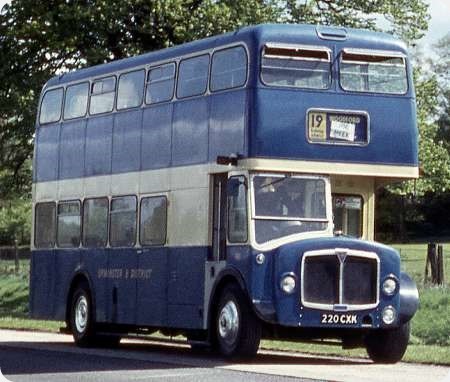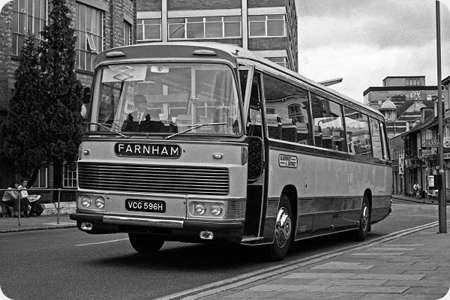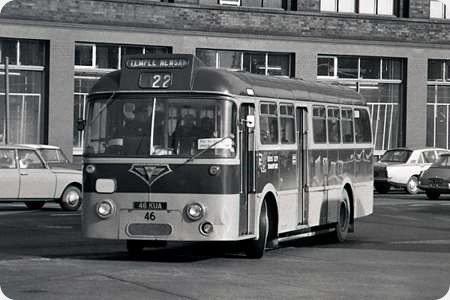Upminster & District – AEC Regent V – 220 CXK
Upminster & District
1961
AEC Regent V 2D2RA
Park Royal H38/31F
In 1961, London Transport bought a Regent V on behalf of BEA to test the practicality of using double deckers on the service between Cromwell Road Air Terminal and Heathrow. The vehicle had a Park Royal H38/17F body, the restricted seating figure arising from the adaptation of the rear section of the lower deck to serve as a large luggage carrying compartment. The 2D2RA chassis had a 9.6 litre AV590 engine coupled with a Monocontrol gearbox. Proving that the double decker concept was feasible, it wore several liveries as it served with BEA for a number of years alongside RMF1254 and then the RMA fleet with their luggage trailers. It was sold in 1968 to Super Coaches (Upminster) Ltd., one of whose trading names was Upminster & District, and the new owner converted it back into standard bus configuration with windows and 31 seats on the lower deck. It is seen here on the HCVC Brighton Run in 1971, where it seemed to be functioning as a support vehicle rather than as an entrant itself.
Photograph and Copy contributed by Roger Cox
09/04/19 – 09:13
Surprisingly, there doesn’t seem to be any references to this vehicle after 1971. Super / Upminster & District were rather fond of AECs and ex London vehicles, probably due to their traffic manager, a young man called Peter Newman. In 2019, as chairman of Ensign Bus, his fleet suggests that he is still very fond of AECs and ex London vehicles.
Nigel Turner
11/04/19 – 06:16
I’m pretty sure that this Regent V was destroyed not long after this picture was taken. I cant recall now if it was a fire or an accident that put paid to it, but think it was the former. I’m sure someone with better knowledge will confirm my thoughts
Malcolm Pelling
13/04/19 – 06:00
I don’t believe that this was taken on the 1971 rally, since by then it had been sold from Super Coaches to City Coaches and on to Ementon, Cranfield.
It’s history is:-
B.E.A, Ruislip 6501 12/61
P.V.S. (London) Limited (dealer), Upminster 5/67
Super Coaches, (Upminster) Limited, Upminster 1/68 re-seated to H37/31F as no 681
City Coach Lines (Upminster), Limited, Upminster No, 506 2/69
S.M. Ementon, Cranfield 10/70
Withdrawn 6/72 after an accident and to Paul Sykes Organisation (dealer), Barnsley 12/72 for scrap. I photographed it with the identical destination setting, including the paper insert, on the 1968 rally as seen in this link.
John Kaye
14/04/19 – 06:11
You are right, John. As you suggest, it was the previous year. My mistake.
Roger Cox
21/04/19 – 07:18
I am not really a bus person (more into coaches) but to me the rather square Park Royal body on 220 CXK looks very similar to the bodies supplied to East Kent also on Regent V chassis, perhaps 220 CXK was tagged onto an EK batch?. I like the coach style wheel discs, Delaine used to have them on their Atlantean d/ds.
Andrew Spriggs
22/08/19 – 10:45
Does anyone know the colours when it was with BEA with BEA Titles? as only B&W pics seem to be available.
Stef
23/08/19 – 06:19
A quick Google found this: https://www.flickr.com/photos/
Geoff Pullin
28/08/19 – 07:04
Thanks. I did find that after further searching.
Stef
Quick links to the - Comments Page - Contact Page - Home Page



